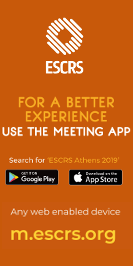Repeatability of iridocorneal angle measurements of Scheimpflug-placido analyser in unoperated and post-refractive surgery eyes
(results will display both Free Papers & Poster)
Session Details
Session Title: Cornea & Miscellaneous
Session Date/Time: Friday 15/02/2019 | 10:30-12:30
Paper Time: 11:48
Venue: Room MC3
First Author: E.Yassa TURKEY
Co Author(s): C. Ünlü T. Kurt
Abstract Details
Purpose:
The Sirius rotating Scheimpflug camera topography is a relatively new eye anterior segment analyser and as for every new device it has to be validated by assessing its repeatability. To the best of our knowledge, only a few works had studied anterior chamber depth (ACD) and anterior chamber volume (ACV) parameters of the device. The repeatability of IA measurements of the Sirius had not been investigated in post refractive surgery eyes to date.
Setting:
Asya Eye Medical Centre, Istanbul,Turkey.
Methods:
We measured IA, ACD, and ACV using a Sirius. Glaucoma summary mode of the Sirius provides nasal and temporal IA values at different angles (specifically; 00, +100, +200, +300, −100, −200, and −300 degrees) automatically and an average value as IA. We calculated repeated measures one-way analysis of variance (ANOVA), intraclass correlation coefficient (ICC), within subject standard deviation (Sw), intrasession test-retest variability, and coefficient of variation (COV) to determine repeatability.
Results:
This study included 50 eyes of 50 subjects without history of refractive surgery with a mean age of 42.6 years and 13 eyes of 13 subjects who had undergone LASIK or PRK with a mean age of 39.1 years. We did not find any statistically significant difference between consecutive measurements using repeated measures ANOVA in both groups. For the average IA, ACD and ACV measurements, repeatability was excellent with ICC > 0.90 in both groups. For the IA measurements at different locations, ICC was higher than 0.75 for all parameters with the exception of some nasal measurements in both groups.
Conclusions:
Iridocorneal angle measurements of the Sirius device at temporal locations showed moderate or high repeatability whereas at nasal locations it showed moderate or poor repeatability in both normal and post-refractive surgery eyes. Considering the poor repeatability of the device in nasal locations, which we observed in both groups, glaucoma mode of the device should not be used in glaucoma screening. On the other hand, average IA, ACV and ACD measurements of the Sirius showed excellent repeatability therefore can be confidently used in clinical practices and for research purposes.
Financial Disclosure:
-



